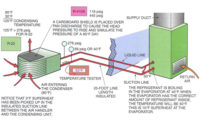Nowadays, when you ask people how to check the charge on a heat pump during low outdoor temps, they will say that you need to “weigh in and weigh out” the charge. While this may be an effective method, it isn’t always practical.
Now… If you are making a refrigerant circuit repair, weighing out and weighing in makes perfect sense, especially since microchannel condensers and scroll compressors make pumping down less viable anyway. But there are many cases where you just need to check the charge to make sure the system is working properly, and in these cases, weighing in and out is just plain silly.
I originally wrote this guideline back in 2003, and truthfully, not much has changed since then in regards to checking a heat mode charge on a heat pump.
Step No. 1: If there is any frost on the outside unit, get it completely defrosted first.
Step No. 2: Check all the obvious things first — filter, coils, blower wheel, etc. If the unit isn’t clean, it will be really hard to check.
When charging in heat mode, read manufacturer specifications first. Lennox gives specific instructions for charging its units in below 65˚ outdoor ambient conditions. It involves blocking off the condenser coil with cardboard — or even better, using a charging jacket — while continuing to run the system in cool mode. Lennox gives specific instructions for how high to raise the head pressure, and what level of subcooling you should expect.
Remember that in heat mode on a heat pump, the evaporator is outside and the condenser is inside. This is important because in cool mode, a dirty air filter caused low airflow on the evaporator. This would typically cause a low suction pressure and a low superheat. In heat mode, a dirty air filter causes low airflow across the condenser. This can cause extremely high head pressure. In heat mode, a dirty outdoor coil can cause a low suction pressure.
As an example, Trane includes a pressure curve chart with many heat pump condensing units. Be sure to use the scale all the way to the right that says heat mode. Indoor and outdoor dry bulb temperatures are necessary to use the Trane pressure curve. Carrier supplies many heat pump condensing units with a pressure guideline chart. Carrier only wants the heat mode pressure chart used as a guideline, not as a charging tool. Always reference manufacturer guidelines before setting any charge.
100˚ OVER AMBIENT RULE OF THUMB
Even though manufacturer specifications should be followed, there are some basic guidelines that will aid in charging and diagnosis in a pinch. The most widely quoted rule of thumb is the 100˚ – 110˚ over ambient discharge rule. This guideline states that a properly charged unit will have a discharge line temperature of 100˚ – 110˚ above the outdoor temperature. If the discharge line is too hot add refrigerant (If the charge is the issue and not another problem). If the discharge line is too cool remove refrigerant (again only if the charge is diagnosed as the issue).
First off, the photo above was taken in 2003 so give me some slack on my gauges. Nowadays, I would be using my Testo 550.
Here's a simple example using the 100˚ – 110˚ over ambient rule. If it were 60˚ outside, you could say by the 100˚ – 110˚over ambient rule, the charge is about correct. If it were 30˚ outside, the 100˚ – 110˚ over ambient rule would show undercharge. If, for example, the discharge temperature were 210˚ with a 150 psi head pressure, a 10 psi suction, and a 50˚ outdoor temperature, this would show an extreme undercharge. Subcool and superheat can still be checked in heat mode, the problem is since there are rarely any set guidelines, it is difficult to tell when the charge is set correctly by simply checking subcool or superheat alone. Generally, you will see normal superheat (8-14) on a system with heat mode TXV. The subcooling will generally be a bit higher than usual, especially when measured outside.
SUCTION PRESSURE / EVAP DTD RULE OF THUMB
Another common old school rule of thumb is suction pressure should be close to the outdoor temperature in a R-22 system. However, this rule of thumb (obviously) does not work on an R-410A system. A more applicable guideline is 20˚-25˚ suction saturation below outdoor ambient. This means if it is 50˚ outside, the suction saturation temperature should be between 25˚and 30˚ (on most systems).
HEAD PRESSURE / CTOA RULE OF THUMB
Because the evaporator coil is substantially smaller than the condenser, you will usually see higher head pressure (condensing temperature) in relationship to the condensing air, or in this case, the indoor air. This can vary a lot depending on the age / SEER of the unit, the size of the coil and how the indoor airflow is setup but generally will be 30˚ – 40˚ condensing temperature over the indoor dry bulb.
CHECKING WITHOUT GAUGES
Here are some quick tests you can do on a heat pump to confirm it is operating close to specs without using gauges when the coil is frost free and the outdoor temps are between 15˚ – 65˚:
- Check the discharge (vapor) line, it should be 100˚ – 110˚ over outdoor ambient temperature;
- Suction line temp should be 5˚ – 15˚ cooler than the outdoor temperature;
- Liquid Line should be 3˚ – 15˚ warmer than the indoor temperature; and
- Delta T indoors will vary greatly depending on outdoor temperature.
If anything looks off, go ahead and connect gauges to verify further…. and like I said several times already, follow manufacturers guidelines.
Publication date: 1/07/2019
Want more HVAC industry news and information? Join The NEWS on Facebook, Twitter, and LinkedIn today!











